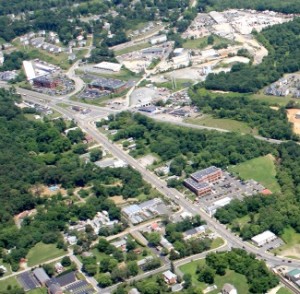Virginia has been at the forefront in the development of public-private partnerships. Perhaps one of the first, and certainly one of the largest, such partnerships led to the construction of the Dulles Greenway from Route 28 to Leesburg, which opened in 1995. It is a privately owned 14-mile highway constructed in partnership with VDOT under the Virginia Highway Corporation Act of 1988. In 1994 Virginia enacted the “Qualifying Transportation Facilities Act,” which morphed a year later into the “Public-Private Transportation Act of 1995,” a statutory framework for the joint public and private development of transportation facilities. Virginia has created a special agency for the development and implementation of a statewide program for project delivery using the PPTA known as “P3 Virginia.” http://www.p3virginia.org/
The success of the PPTA led the General Assembly to enact the Public-Private Education Facilities and Infrastructure Act of 2002, found in the Virginia Code at § 56-575.1, et seq. The PPEA is detailed and complex, but it fundamentally authorizes private entities to acquire, design, construct, improve, renovate, expand, equip, maintain, or operate what are called “qualifying projects” after obtaining approval (and often participation) of a public entity.
It is this statute, because of exceptional breadth not fully revealed by its title, that has been used to create beneficial partnerships between the private sector and governmental agencies. It has, for example, been the means by which more than 150 projects have been conceived, financed, and built in Virginia. George Mason University has used it to construct an extraordinary science center at Belmont Bay, and the Commonwealth has used it to make improvements to Capitol Square. State and local agencies have built elementary and high schools, sewer treatment facilities, fire stations, jails, libraries, and performing arts centers among dozens of other projects.
What constitutes a qualifying project extends far beyond educational facilities, and is essentially limited only by the ingenuity of the private sector. Such projects include (i) any education facility including stadia or other facilities primarily used for school events; (ii) buildings or facilities that “meet a public purpose” and are developed or operated by or for any public entity; (iii) improvements, together with equipment, necessary to enhance public safety and security of buildings to be principally used by a public entity; (iv) utilities, telecommunications, and other communications infrastructure; (v) recreational facilities; (vi) technology infrastructure, services, and applications; (vii) services designed to increase the productivity or efficiency of the responsible public entity through the use of technology or other means; (viii) any technology, equipment, or infrastructure designed to deploy wireless broadband services to schools, businesses, or residential areas; (ix) “improvements necessary or desirable to any unimproved locally- or state-owned real estate”; and (x) any waste management facility that produces electric energy derived from solid waste.
Although public agencies may issue requests for proposals for PPEA submissions, one of the most elegant and important features of the PPEA is that private actors can simply submit an unsolicited proposal for a qualifying project to any agency, institution, or locality in the Commonwealth. The private sector may, therefore, drive the development process to determine if it has a willing partner. (Although proposals may be unsolicited, there is no prohibition on prior discussions with an agency or locality to determine whether there may be interest in such a project.) Once projects are developed, they may be privately owned and operated, and revenues and expenses shared between the private and public parties.
Before it can accept a PPEA submission, the public agency is required to develop detailed review guidelines. Significantly, the public agency must provide opportunities for competition through public notice. It is required to give reasonable time (not less than 45 days) for others to submit competing offers that the agency is obliged to review and consider. The guidelines must also incorporate provisions for financial review and analysis procedures to include such things as a cost-benefit analysis, an assessment of opportunity cost, and consideration of the results of all studies and analyses related to the proposed qualifying project.
The extensive requirements for the contents of a PPEA submission, whether unsolicited or otherwise, are set out in detail at § 56-575.4 of the Code [http://leg1.state.va.us/cgi-bin/legp504.exe?000+cod+56-575.4]. Depending on the project, the requirements include maps, descriptions to include conceptual designs, means by which the private sector will acquire the necessary property interests, and general plans for financing, including the sources of the private entity’s funds and identification of any revenue sources that may be generated by the project itself. Proprietary and confidential information may be protected under a specific exemption for PPEA data provided in the Virginia Freedom of Information Act.
Once the locality has reviewed the detailed information required and has chosen to go forward with a PPEA project, the parties then enter into either an interim or comprehensive agreement. An interim agreement, executed prior to or in connection with the negotiation of the comprehensive agreement, permits the private entity to commence activities for which it may be paid and that relate to the qualifying project, and creates the process and timing for negotiation of the comprehensive agreement. The comprehensive agreement, as the name suggests, is to be entered into prior to the actual development or operation of the qualifying project and contains extensive and detailed provisions relating to bonding, review of plans and specifications, inspections, insurance, monitoring, financing, user fees, lease payments, or service payments associated with the development and use of the project. In many cases, the parties skip the interim agreement process and go straight to final agreement.
The Virginia Department of General Services has developed procedures for state agencies and institutions that govern Commonwealth projects, and most localities have posted their guidelines online. http://dgs.virginia.gov/PPEA/tabid/62/Default.aspx
Walsh, Colucci, Lubeley & Walsh, P.C., has extensive experience with PPEA projects. For further information, call John Foote at 703.680.4664.







